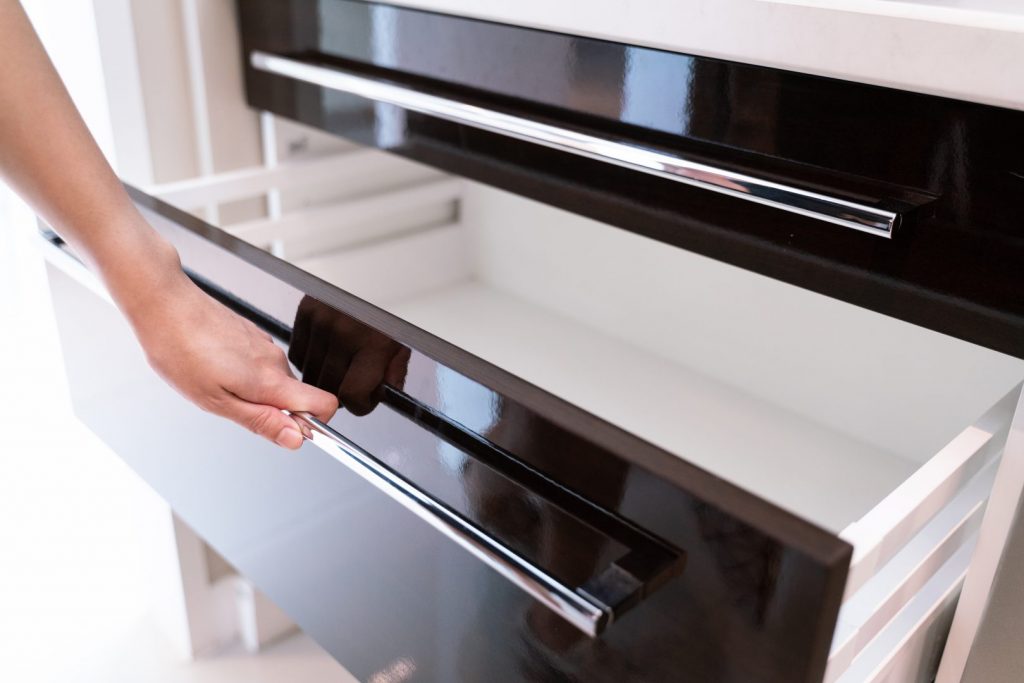
This large drawer pull allows a person to use one or two hands to grasp and open the drawer with more control rather than having a small knob or handle to use
There are many aspects to consider in evaluating how well a home can allow its occupants to age in place effectively and then to take those impressions and create modifications of that living space to facilitate a more successful future. Part of this review and analysis involves considering the physical setting of the home and what it entails, and part of the assessment focuses on the physical nature and abilities of the occupants of the home.
Sometimes the physical attributes of the home influence more of what we want to suggest to make that dwelling more serviceable for its occupants, and sometimes we are more concerned about the functional abilities of the occupants for our suggestions. Occasionally, it’s a combination of both.
One such factor that is a combination of the physical characteristics of the home and the functional abilities of the occupants involves the hands and how they reach, grasp, grip, hold onto, use, and control various objects in the home.
Our hands perform many functions for us and are extremely versatile tools for doing many of the things that we need to perform on a daily basis. Our fingers have the ability – subject to joint stiffness, arthritis swelling, and other conditions that might make them somewhat painful or limit their full extension and bending or flexion – to touch objects, feel them, sense their shape and finish, determine their relative temperature (hot, cold, or neutral), pick them up, move them, set them down, control them, or hold them.
We think of our hands as doing the work of grasping and lifting, but without the finders doing their part to secure and hold onto objects, the hands would not be near as functional.
So, in our analysis of how effective our homes are for general living, and more specifically aging in place living – with an eye for people living in their home long-term, regardless of their current age or level of ability – we need to focus on manual activities. That is, how easy is it for our hands to do things in the home?
Let’s start with three features that are common in every home and are ones that often challenge our fingers and hands. First, is the door handle. The entry door handle that is popular is the elongated loop handle with a thumb latch that must be depressed to release the bolt. These come in many finishes and are quite attractive, but they are not a universal design feature and create issues for many people. It takes thumb strength to push down on the release. It takes a sizeable span to extend one’s thumb to reach the latch release while continuing to grip the loop handle. Then it takes enough coordination and thumb strength to make everything work at the same time. Otherwise, two hands need to be used – one to push down on the release and one to pull the handle once the bolt has been retracted.
A much simpler method is to install a lever handle – with or without a keypad locking mechanism – because it can be operated so effortlessly. It can be grasped with the open hand or pushed down to release the bolt with a fist, the heel of the hand, an elbow, two fists, or an object being held – and can be operated while wearing thick or bulky gloves or mittens as well. Using this door handle does not depend on hand strength or one’s ability to fully engage the handle.
The same principle is true for interior door handles, and they should all be replaced with lever handles. Rather than needing to close our hand around a smooth or textured round door knob and then having enough strength, grip, or range of motion to turn the handle, we can open the door by pushing down on the lever handle the same as we would do for the exterior door.
The second feature is the light switch. If the small toggle-style light switches are still in use, they need to be replaced with the rocker-style switches that require much less effort to operate and do not take near the amount of accuracy to use them effectively. Touch the rocker switch most anywhere on its surface and it will work. Also, it doesn’t need much pressure applied. This saves our hands and fingers from extra work and is especially kind to hands with mobility difficulties.
Third, we want to change all of the difficult to grasp and use knobs and handles on cabinets and drawers – in the kitchen, bathroom, laundry, and other storage areas – to larger, easier to use pulls and handles. Rather than the small round knobs or the small, low profile handles
that are hard for many people to grasp and then use to control a drawer or cabinet door due to lack of leverage, a loop or bar that is long enough and deep enough to allow a person to extend their fingers into the space between the drawer or cabinet surface and the bar and then grasp the bar (with one or both hands) gives them more control and strength to open it.
There are many other areas of the home that we want to focus on that involve considerations for our hands, but this is a good beginning.
